Links are not working yet but they are there!
http://www.pentax.co.uk/en/Photo-Downloads.html#MediaTypeID4
Let's see what will be offered.
On the other hand and unfortunately, there is no update of firmware for the K-r. It seems that the firmware support to the K-r by Pentax has already ended.
Update (1-3): The 1.12 items have been withdrawn by Pentax UK in the above page.
• News about Products and Latest Company Direction
• Summaries of Reported Problems and Potential Issues
• Technical Articles on Photographic Gear and Technologies
Saturday, December 31, 2011
Friday, December 23, 2011
Take Google Maps Offline and Use

Seasonal holidays have come near and quite some people start to travel. Nowadays, Google maps is a very convenient online tool for checking locations and planning routes but however, they are designed to be used online! But usually when we are travelling overseas, we do not want to use mobile internet access outdoor of which the charge can be very expensive (or simply do not have it btw).
So, can we view the Google map offline? Here is a very useful article for the tips as a quick guide. See:-
http://www.makeuseof.com/tag/how-to-download-google-maps-for-offline-use/
Note that the software tool that is recommended, the "Google Map Buddy", is now unavailable for download from the original webpage of the software author. But however, it still can be found on the Internet by doing a quick search, which is yet not too difficult to find, I believe.
And, some additional tips and remarks of mine about the displayed language(s) of the maps when using and downloading Google maps:-
1. The Google map languages are the ones that are set to be official at particular place and country by the government. For example, the default map language when you go to Hong Kong's maps are offered in both Traditional Chinese and English. By default, when an internet user read the Hong Kong Google maps, it displays Chinese, e.g.:-
http://maps.google.com.hk/
In fact, the user will see no difference even when he/she first searched at http://maps.google.com/ and then eventually go to the Hong Kong region..
But unfortunately, if you do not read Chinese (as a foreigner, for most cases) but planned to go there, a map in Chinese would be helpless! :-o So, the standard method recommended by Google is to first switch the language at the front page to English, provided that it is just one of the "offered" official languages. The language selection can be found at the left-side bar. Alternatively, we can simply type in an command in the URL like this, directly:-
http://maps.google.com.hk/?&hl=en
Then the page interface will be switched to English and most importantly, the maps will now also have the English language and text overlaid on it, in addition to the original local language.
So, the "magic" is just the "?hl=en" characters that follow.
2. With the same trick and actually the issue of a specific command, now the Google Map Buddy can also be instructed to select the language when it downloads the maps!
This is the Toolbar display which the user should select before any map can be downloaded (after clicking the "Create Map Image" button and type in the file name):-

Note in the above that the content of the original default command line of hl=[HL] is now changed to hl=[EN] and that "Source URL" checkbox should be re-selected afterwards. That's it!
Enjoy! Merry Christmas and a Happy Holiday! :-D
Thursday, December 22, 2011
Pentax Q Won in a Recent (Japanese) Poll in Popularity for Digital Cameras in 2011

http://dc.watch.impress.co.jp/docs/review/special/20111221_500474.html
(in Japanese, Google English Translation Here)
It beats the NEX-7 and the EOS 1DX and has got the Number One! Wonderful? :-D
Well, it seems that we Pentaxians and actually many fans are always keenest and be the most united when it comes to those cyber pollings. But then practically the sale results and figures of the Pentax products are not so good, just read those BCN results to compare if wanted! So? :-o
Wednesday, December 21, 2011
New Pentax SLR Toys, Lens Interchangeable


The toy policy of the old Hoya continues under the current control of Ricoh and it has been realised! Look!
http://dc.watch.impress.co.jp/docs/news/20111221_500459.html
(Google English Translation Here)
The product description mentions that it is targeted for those aged 10 years and up.
Btw, I'm really interested! Will try to get them if I can find them later on! And most importantly, I think I'll be 10 years old for getting them! ;-D
Related:-
Pentax' Toy Policy Will Continue After Ricoh's Take-Over in October!
My K-r Toy Story! ;-D
Tuesday, December 20, 2011
True Round Diaphragm Pentax Lens!
This must be the true round diaphragm Pentax lens ever! See:-

Via: http://forums.dpreview.com/forums/readflat.asp?forum=1036&thread=40088160
It has even two more blades for what I saw and reported for the last time:-
http://ricehigh.blogspot.com/2010/11/round-lens-diaphragm-see-this-o.html
Wonderful! The bokeh of this Takumar must be good! And, Pentax wins (won actually) other once again, eventually! ;-D

Via: http://forums.dpreview.com/forums/readflat.asp?forum=1036&thread=40088160
It has even two more blades for what I saw and reported for the last time:-
http://ricehigh.blogspot.com/2010/11/round-lens-diaphragm-see-this-o.html
Wonderful! The bokeh of this Takumar must be good! And, Pentax wins (won actually) other once again, eventually! ;-D
Pentax Q DPR Samples
In-camera or ACRed, full-size "originals" are available:-
http://www.dpreview.com/galleries/reviewsamples/albums/pentax-q-preview-samples
http://www.dpreview.com/galleries/reviewsamples/albums/pentax-q-preview-samples
Full Translation of the Kitazawa Interview (Head of Pentax R&D)
Someone has compiled a full English translation of the whole interview, here it is:-
http://www.pentaxforums.com/forums/pentax-news-rumors/168982-translation-kitazawa-interview.html#post1749610
Whilst actually there is not any new particular information that you will get, it would be good to view the original context in full, just in case if you're yet interested.
http://www.pentaxforums.com/forums/pentax-news-rumors/168982-translation-kitazawa-interview.html#post1749610
Whilst actually there is not any new particular information that you will get, it would be good to view the original context in full, just in case if you're yet interested.
Monday, December 19, 2011
Round Table Interview with Eight Major Camera Makers (Including Both Pentax and Ricoh)
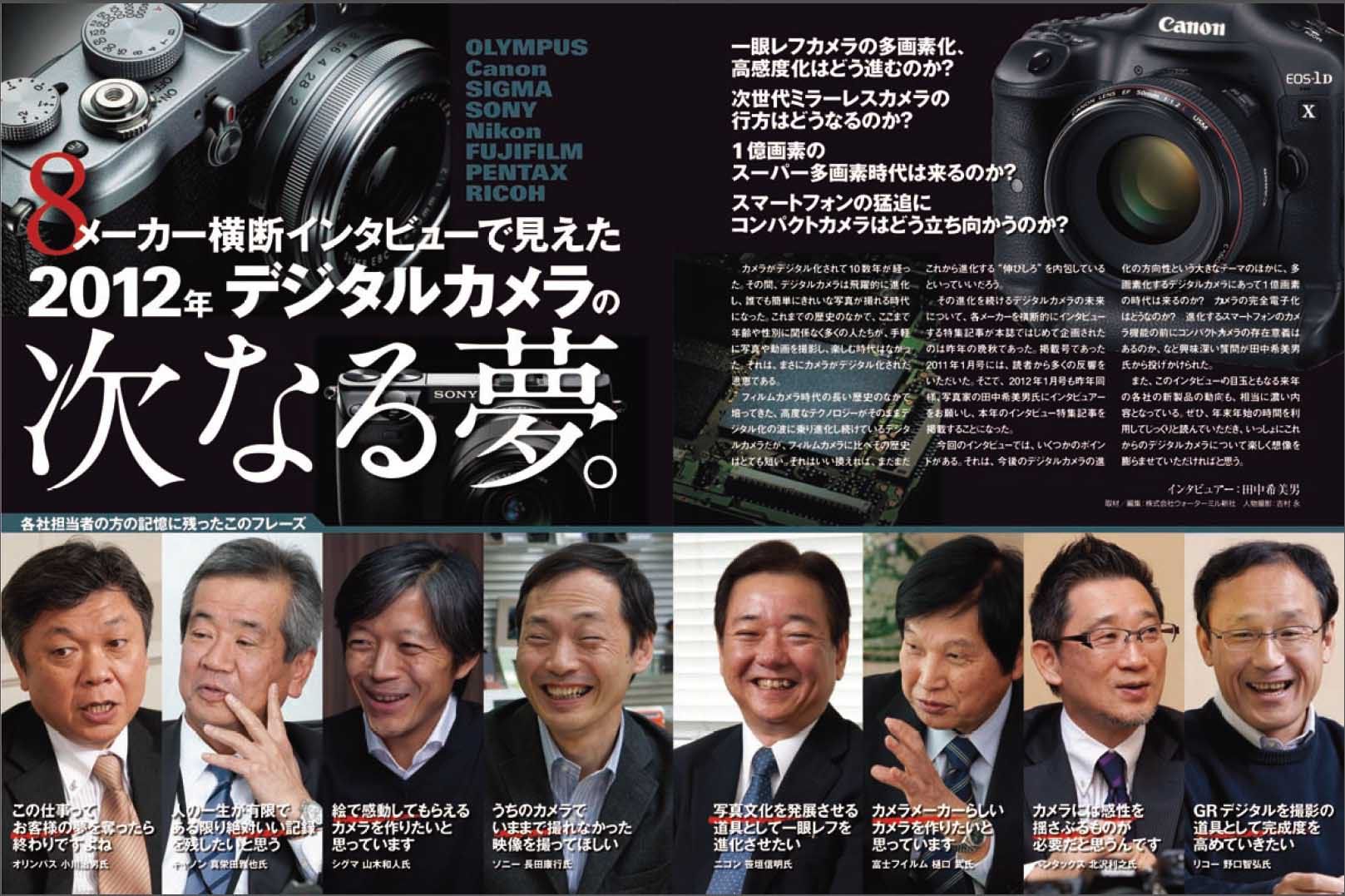
The said interview from the Japanese printed "Digital Camera Magazine" has really been published today:-
https://www.impressjapan.jp/pr/monitor/1112_dcm/271201_free.pdf
Via: Xitek Forum Post Here with Human Chinese Translation for a Full Summary in point form.
(Google Translation on the above Xitek Post to English Here)
So here we go, for what is Pentax related. And, the last "rumour" of the top officials of Pentax Ricoh were interviewed is true. My human translation on the Xitek post is as follows:-
From Head of Pentax:-
1. They are exploring and doing researches for Full Frame and 645D mirrorless;
2. All upcoming "DSLRs" of Pentax will have 100% field of view coverage, even for entry level models;
3. The FF and 645D mirrorless is only the personal thinking of the Head himself! :-o So? (But Head is Head, i.e., decision maker!);
From Head of Ricoh:-
1. (GXR) Module adapting Pentax (K-mount) lenses will be made;
2. Pentax Unrelated: A zoom GRD is being developed.
Oh, well.. Anyway, if you are interested about what are told by the six other top officials of other companies, go through the Google translation by yourself above (if it is understandable)! ;-) Btw, one of the more important news of the others is that Canon confirms for the first time officially that they will make/market a new EVIL/mirrorless in 2012, finally and at last.
Sunday, December 18, 2011
Hot Pentax Rumour 2: 135 FF Mirrorless is Considered, Talked Head of R&D!
http://thisistanaka.blog66.fc2.com/entry/662/
(in Japanese, English Translations Here: Google or Excite)
via Peter Fang at DPR Forum
Quoted, "I don't know Japanese that much but it looks like Mr. Kitazawa, head of Pentax's camera R&D, told Japan's Digital Camera Magazine that Pentax is working on a mirror-less 35mm full-frame camera and is even considering a mirror-less 645D.
Last Story:-
Latest Pentax Rumour: New 24MP Full Frame DSLR and APS-C ILDC are Coming!
(in Japanese, English Translations Here: Google or Excite)
via Peter Fang at DPR Forum
Quoted, "I don't know Japanese that much but it looks like Mr. Kitazawa, head of Pentax's camera R&D, told Japan's Digital Camera Magazine that Pentax is working on a mirror-less 35mm full-frame camera and is even considering a mirror-less 645D.
It will be greatly appreciated if someone from Japan could give us more insights by reading this magazine, to be published on Dec. 19 according to this blog."
Well, a FF *mirrorless*? A 645 mirrorless? What? WTF?! >:-oLast Story:-
Latest Pentax Rumour: New 24MP Full Frame DSLR and APS-C ILDC are Coming!
Friday, December 16, 2011
A Deeper Technical Investigation into K-r's Front Focusing Issue under Tungsten (Part 2)
This Post is Continued from the Last Part.
After all those tests and measurements and with much hope in resolving the problem, I quickly acquired an IR block/stop/cut filter to see IF the problem could be eliminated:-
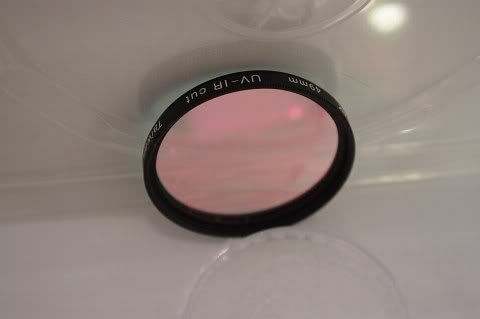
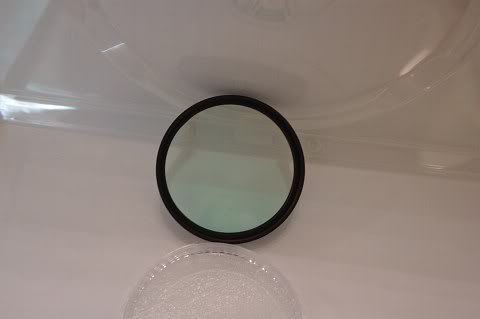
The filter is essential a glass filter with heat reflective coating on it. As such, it is also known as hot mirror, besides calling it a IR blocking filter. (More product brochures can be found here for the B+W and here for the Heliopan.)
A typical wavelength response on the light spectrum is as follows:-

It can be observed that such a filter does reflect red or green light when viewed from a large angle of incidence. In contrast, when it is viewed near perpendicularly, it is clear. Hence, these filters should not be used for wider lenses for an Angle of View greater than 60 degrees, i.e., at about 35mm 135 film equivalent. Theoretically, it has virtually no light loss for visible light and thus the EV drop should be zero and it is negligible.
Now, that's the most important part which we are looking for - the Results! Of course all tests were carried out under the same pure tungsten environment (at the same time). This time I only tested at 35mm of the focal, which was found to have a more dominant effect for the problem than the tele-side:-
Well, once again, the best focus was achieved with Live View. With the help of the IR block filter, the front focusing symptom has been relieved somehow, but only partially! :-( Now that the focusing error seems to be halved in this case and indeed it even did slightly better than making Focus Adjust at a full span backwards at -10 as allowed. Most possible focus correction was achieved with the use of IR cut filter together with a Focus Adjust at -10 - but it was still NOT there for exactly where the Live View could reach! :-o
To explain the half-failure (and half-success anyway!) of this IR cutting remedial, there are at least two possibilities:-
1. The IR block filter is not strong enough to reject all the harmful IR lights from tungsten and the SAFOX IX is just too sensitive to those;
2. The harmful IR light or near-IR lights are out of the flat rejection band of the filter such that the filtering is not as effective as desired. As such, some improvement can be seen but yet the problem is not totally eliminated!
No matter how, at the end of the day, Pentax must be blamed for the in-born latent defect and that complete design fault of the SAFOX IX system that they created. In fact, this fault is a very serious one and is unforgivable for the large amount of focusing error that is produced! >:-[
Nevertheless, I am still feeling somehow good to find out and know about the truth and then to report in details here for what I've discovered. It is a tragedy for all we K-r and actually all Pentax users after all as it is seen that Pentax created an inferior AF system like this. I do hope that it should *never* happen again in the Pentaxland, for any new Pentax body to come!
N.B. Last time I used an entry level Canon 550D (for a complete month), it never had this kind of front focusing problem under tungsten and the AF had been dead accurate! >:-(
Related:-
Pentax UK and Pentax Germany Admitted K-r Tungsten Front Focusing Issue (But there is No Solution, as Both Clearly Told)
Still Annoying K-5 and K-r Old Issues, Users are Pissed Off!
SAFOX IX Tungsten/Yellow Light Front Focus Issue Fully Investigated
After all those tests and measurements and with much hope in resolving the problem, I quickly acquired an IR block/stop/cut filter to see IF the problem could be eliminated:-


The filter is essential a glass filter with heat reflective coating on it. As such, it is also known as hot mirror, besides calling it a IR blocking filter. (More product brochures can be found here for the B+W and here for the Heliopan.)
A typical wavelength response on the light spectrum is as follows:-

It can be observed that such a filter does reflect red or green light when viewed from a large angle of incidence. In contrast, when it is viewed near perpendicularly, it is clear. Hence, these filters should not be used for wider lenses for an Angle of View greater than 60 degrees, i.e., at about 35mm 135 film equivalent. Theoretically, it has virtually no light loss for visible light and thus the EV drop should be zero and it is negligible.
Now, that's the most important part which we are looking for - the Results! Of course all tests were carried out under the same pure tungsten environment (at the same time). This time I only tested at 35mm of the focal, which was found to have a more dominant effect for the problem than the tele-side:-
| Condition | Record of the Focus Scale for where AF was Measured | Result Image (Central 100% Crop) | Result Image (Large and Uncropped) |
| Without IR Cut Filter, Optical PMAF | 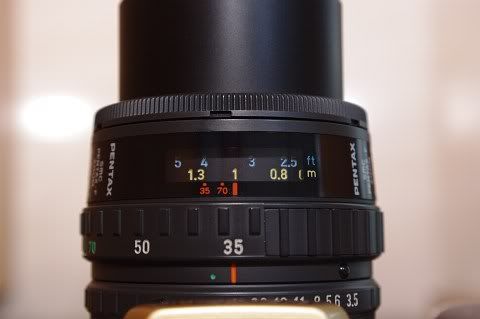 | View | Download |
| With IR Cut Filter, Optical PMAF |  | View | Download |
| With IR Cut Filter, Live View CDAF | 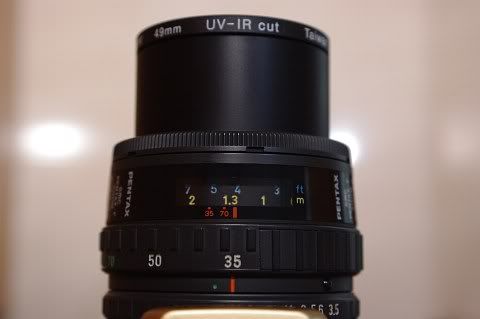 | View | Download |
| Without IR Cut Filter, Focus Adjust at -10 (Max.), PMAF | 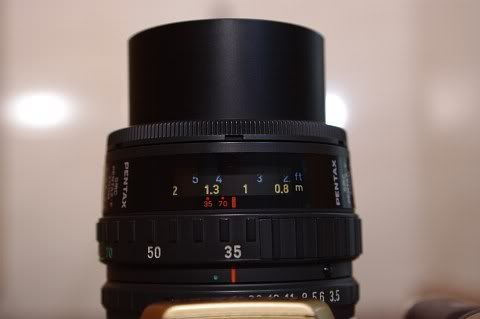 | View | Download |
| With IR Cut Filter, Focus Adjust at -10 (Max.), PMAF | 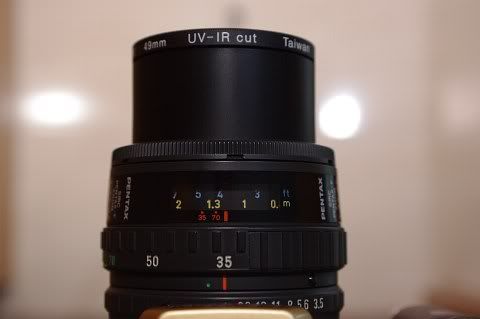 | View | Download |
Well, once again, the best focus was achieved with Live View. With the help of the IR block filter, the front focusing symptom has been relieved somehow, but only partially! :-( Now that the focusing error seems to be halved in this case and indeed it even did slightly better than making Focus Adjust at a full span backwards at -10 as allowed. Most possible focus correction was achieved with the use of IR cut filter together with a Focus Adjust at -10 - but it was still NOT there for exactly where the Live View could reach! :-o
To explain the half-failure (and half-success anyway!) of this IR cutting remedial, there are at least two possibilities:-
1. The IR block filter is not strong enough to reject all the harmful IR lights from tungsten and the SAFOX IX is just too sensitive to those;
2. The harmful IR light or near-IR lights are out of the flat rejection band of the filter such that the filtering is not as effective as desired. As such, some improvement can be seen but yet the problem is not totally eliminated!
No matter how, at the end of the day, Pentax must be blamed for the in-born latent defect and that complete design fault of the SAFOX IX system that they created. In fact, this fault is a very serious one and is unforgivable for the large amount of focusing error that is produced! >:-[
Nevertheless, I am still feeling somehow good to find out and know about the truth and then to report in details here for what I've discovered. It is a tragedy for all we K-r and actually all Pentax users after all as it is seen that Pentax created an inferior AF system like this. I do hope that it should *never* happen again in the Pentaxland, for any new Pentax body to come!
N.B. Last time I used an entry level Canon 550D (for a complete month), it never had this kind of front focusing problem under tungsten and the AF had been dead accurate! >:-(
Related:-
Pentax UK and Pentax Germany Admitted K-r Tungsten Front Focusing Issue (But there is No Solution, as Both Clearly Told)
Still Annoying K-5 and K-r Old Issues, Users are Pissed Off!
SAFOX IX Tungsten/Yellow Light Front Focus Issue Fully Investigated
Thursday, December 15, 2011
A Deeper Technical Investigation into K-r's Front Focusing Issue under Tungsten (Part 1)
I started a more systematic approach to investigate the tungsten front focus problem of the K-r and see what's wrong with the design of that SAFOX IX AF system that is used.
To begin with, I tested the camera in a dark room, selected an object with a flat surface on which there was clear contrasty patterns, and then projected pure Red light (using the spotbeam projector of an external dedicated Pentax flashgun) and Green light (using the built-in AF assist light) onto the target and did the AF. The results were: NO problem for both, the AF was fairly accurate!
I then tried the Blue light. But since I could not find a pure Blue light source for projection. I used pure 6000K White light source and then put on a 80A (Blue) filter and did the same test. Again, the AF had been *accurate*! :-o
As such, I re-thought again.. What lights actually a tungsten bulb contains? It is Yellow light, which should be somewhere between the Red and Green for the wavelength in the visible light spectrum.
But however, since the above investigations shown that it is not the problem with neither Red nor Green and thus it is safely derived that Yellow light should cause no problem neither. So, actually what is the real *source* of problem? Could it be the Infrared? Which was just invisible, as tungsten does also emit very strong Infrared, as a heat source more than a light source actually.
Some time later, I picked out my old Pentax F35-70 AF lens, which has two Infrared focusing marks on the distance scale. I then tried to shoot under a *pure* tungsten environment that was actually fairly bright, at 260 Lux:-
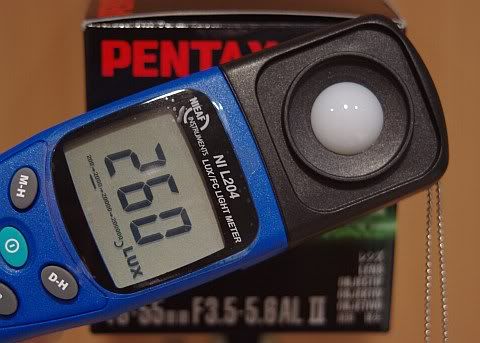
The camera was set up like this and the shoot target is also shown below:-
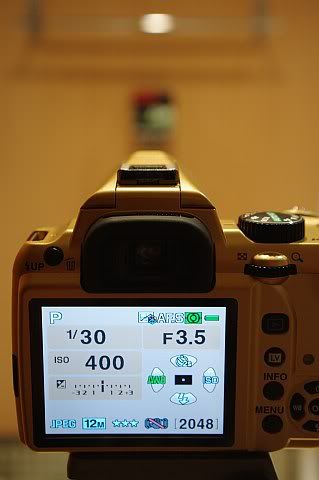
(Firmware in Camera is the Latest, i.e. V1.11; Focus Fine Adjustment was Disabled.)
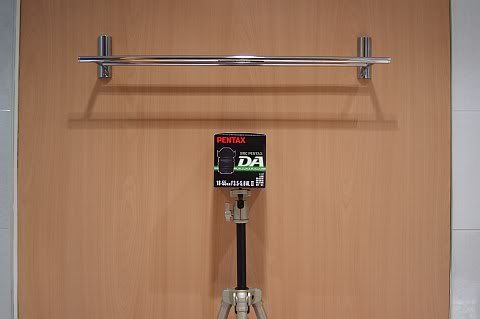
Below are the test results obtained:-
After all, what do you observe above? Indeed, Live View CDAF always measured correct focuses, whilst front focusing *had to* be resulted with PMAF under tungsten. Now, as seen from the above, it is confirmed that amount of errors and the shifts in distances from the correct focus points are very close to the indicated derivation with the IR marks from the central focus mark for normal (visible) light. This holds true for both 35mm and 70mm respectively! That's say if we shoot Infrared film with our Pentax K-r cameras, then the results *should* be mostly correct! :-o
It should be further noted that the effect and amount of error is lower for tele than wide angle, i.e., the magnitude of the distance error is larger as focal length becomes shorter. Indeed, this is what shown on the Infrared marks on the above lens, already.
But since that all Pentax DSLRs are 1.5X cropped with the APS-C sized sensors inside, a shorter focal length is always used for the same Angle of View. As such, the effect of this error is magnified! >:-(
Now, I just could never imagine that after twenty something years, the Infrared marks of my old lens have been useful again, but they are used in another way, i.e., instead of to put the focus to a closer distance, the lens should be manual focus to a farther distance! :-o
After all these, it seems that the main cause of the problem is about the existence of Infrared light in the shooting environment, which is received by the AF module and ultimately onto the sensor and then the whole focus measurement is flawed! The fact is that the those SAFOX IX Pentax DSLRs had to focus on IR instead of visible light when IR is existent and they are rather too sensitive to it! Really damn it! >:-(
In fact, the old AOC Pentax engineers knew about the adverse effect of the Infrared light to the AF system when the original SAFOX (I and II) was designed and created, see this diagram (Credit: Bojidar's Pentax K-mount Page):-

Where the component #5 in the above is just the Infrared Filter!
I am 100% sure that neither my SFX (the first Pentax mass-production AFSLR) nor my MZ-S (which is the second last Pentax 135 film SLR) that uses the older SAFOXes did suffer from this tungsten front focusing issue. There was no nightmare of this issue not until I acquired my *ist D, the first Pentax DSLR, back to January 2004!
So, am I going to resolve this tedious and super annoying problem, which is simply a latent design flaw and defect of the K-r (and many of the Pentax DSLRs) created by Pentax? We shall see in the next/coming part of my report.
Continued on the Next Part.
Previous Related:-
Pentax UK and Pentax Germany Admitted K-r Tungsten Front Focusing Issue (But there is No Solution, as Both Clearly Told)
SAFOX IX Tungsten/Yellow Light Front Focus Issue Fully Investigated
To begin with, I tested the camera in a dark room, selected an object with a flat surface on which there was clear contrasty patterns, and then projected pure Red light (using the spotbeam projector of an external dedicated Pentax flashgun) and Green light (using the built-in AF assist light) onto the target and did the AF. The results were: NO problem for both, the AF was fairly accurate!
I then tried the Blue light. But since I could not find a pure Blue light source for projection. I used pure 6000K White light source and then put on a 80A (Blue) filter and did the same test. Again, the AF had been *accurate*! :-o
As such, I re-thought again.. What lights actually a tungsten bulb contains? It is Yellow light, which should be somewhere between the Red and Green for the wavelength in the visible light spectrum.
But however, since the above investigations shown that it is not the problem with neither Red nor Green and thus it is safely derived that Yellow light should cause no problem neither. So, actually what is the real *source* of problem? Could it be the Infrared? Which was just invisible, as tungsten does also emit very strong Infrared, as a heat source more than a light source actually.
Some time later, I picked out my old Pentax F35-70 AF lens, which has two Infrared focusing marks on the distance scale. I then tried to shoot under a *pure* tungsten environment that was actually fairly bright, at 260 Lux:-

The camera was set up like this and the shoot target is also shown below:-

(Firmware in Camera is the Latest, i.e. V1.11; Focus Fine Adjustment was Disabled.)

Below are the test results obtained:-
| AF Method and Focal | Record of the Focus Scale for where AF was Measured | Result Image (Central 100% Crop) | Result Image (Large and Uncropped) |
| @ 35mm, Optical Phase-matching AF |  | View | Download |
| @ 35mm, Live View Contrast-detection AF | 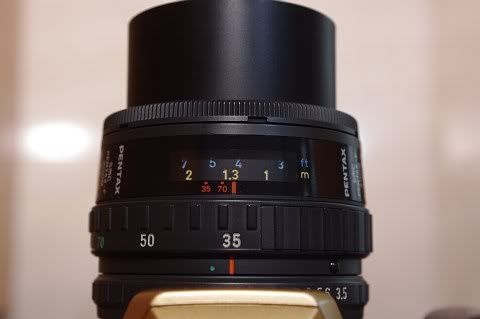 | View | Download |
| @ 70mm, Optical Phase-matching AF | 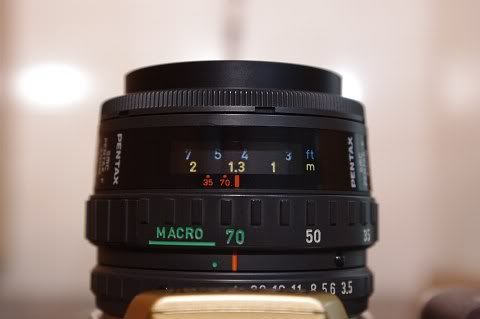 | View | Download |
| @ 70mm, Live View Contrast-detection AF | 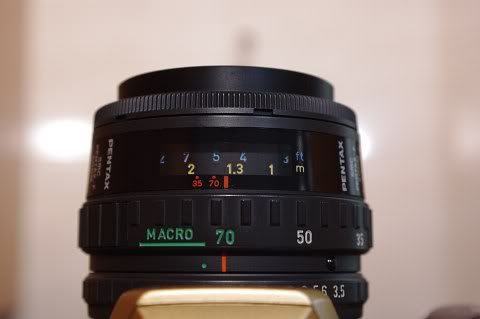 | View | Download |
After all, what do you observe above? Indeed, Live View CDAF always measured correct focuses, whilst front focusing *had to* be resulted with PMAF under tungsten. Now, as seen from the above, it is confirmed that amount of errors and the shifts in distances from the correct focus points are very close to the indicated derivation with the IR marks from the central focus mark for normal (visible) light. This holds true for both 35mm and 70mm respectively! That's say if we shoot Infrared film with our Pentax K-r cameras, then the results *should* be mostly correct! :-o
It should be further noted that the effect and amount of error is lower for tele than wide angle, i.e., the magnitude of the distance error is larger as focal length becomes shorter. Indeed, this is what shown on the Infrared marks on the above lens, already.
But since that all Pentax DSLRs are 1.5X cropped with the APS-C sized sensors inside, a shorter focal length is always used for the same Angle of View. As such, the effect of this error is magnified! >:-(
Now, I just could never imagine that after twenty something years, the Infrared marks of my old lens have been useful again, but they are used in another way, i.e., instead of to put the focus to a closer distance, the lens should be manual focus to a farther distance! :-o
After all these, it seems that the main cause of the problem is about the existence of Infrared light in the shooting environment, which is received by the AF module and ultimately onto the sensor and then the whole focus measurement is flawed! The fact is that the those SAFOX IX Pentax DSLRs had to focus on IR instead of visible light when IR is existent and they are rather too sensitive to it! Really damn it! >:-(
In fact, the old AOC Pentax engineers knew about the adverse effect of the Infrared light to the AF system when the original SAFOX (I and II) was designed and created, see this diagram (Credit: Bojidar's Pentax K-mount Page):-

Where the component #5 in the above is just the Infrared Filter!
I am 100% sure that neither my SFX (the first Pentax mass-production AFSLR) nor my MZ-S (which is the second last Pentax 135 film SLR) that uses the older SAFOXes did suffer from this tungsten front focusing issue. There was no nightmare of this issue not until I acquired my *ist D, the first Pentax DSLR, back to January 2004!
So, am I going to resolve this tedious and super annoying problem, which is simply a latent design flaw and defect of the K-r (and many of the Pentax DSLRs) created by Pentax? We shall see in the next/coming part of my report.
Continued on the Next Part.
Previous Related:-
Pentax UK and Pentax Germany Admitted K-r Tungsten Front Focusing Issue (But there is No Solution, as Both Clearly Told)
SAFOX IX Tungsten/Yellow Light Front Focus Issue Fully Investigated
Wednesday, December 14, 2011
CIPA Specification Guideline for Digital Cameras
Document CIPA DCG-002-2007:-
In English: http://www.cipa.jp/english/hyoujunka/kikaku/pdf/DCG-002_E.pdf (Translated Version)
In Japanese: http://www.cipa.jp/hyoujunka/kikaku/pdf/DCG-002_J.pdf (Original Document)
An interesting document which quotes the reference (inter)national standards and illustrates some of the basic definitions of parameters, the preferred formats and the testing methods, etc. Worth to have a look if you're interested in all those technical stuff.
N.B. CIPA stands for (the Japanese) Camera & Imaging Products Association.
In English: http://www.cipa.jp/english/hyoujunka/kikaku/pdf/DCG-002_E.pdf (Translated Version)
In Japanese: http://www.cipa.jp/hyoujunka/kikaku/pdf/DCG-002_J.pdf (Original Document)
An interesting document which quotes the reference (inter)national standards and illustrates some of the basic definitions of parameters, the preferred formats and the testing methods, etc. Worth to have a look if you're interested in all those technical stuff.
N.B. CIPA stands for (the Japanese) Camera & Imaging Products Association.
The Most Silly and Useless Review by DC Watch, Ever!

For most of the time, DC Watch reviews are useful and interesting. But this time, I'm afraid they have made junk:-
http://dc.watch.impress.co.jp/docs/review/special/20111213_498083.html
Well, we all knew that the P-Q is the smallest and lightest ILDC on Earth. So, these size and weight comparisons by actual measurements are mostly meaningless. But the most silly part of the review is about the marking scheme it adopts!
Just say when it compares for the first time about the weight of the body (without flash, if it is detachable) for which the Pentax Q wins and gets a full mark of 5 points. But then in the next part it compares the weight of those bodies with the flash mounted (if it is detachable) and then the Q wins another 5 points. Indeed, this violates the basic principle of statistical analysis for calculating the weighted score, as actually just for this part of assessment for nearly the same thing has been double counted.
To illustrate this fundamental flaw, should the DC Watch reviewer measure the weight of the bodies for four times? That is, the first time for body only, the second time for body+battery, the third time is for body+battery+card and finally the body+battery+card+flash for the last time? And then, the Pentax Q will get a total of 20 full marks, i.e., four times for the weighting! See? :-o
In fact, the above example, although looks rather silly as it does, is not exaggerated. The reviewer did continue measure the combined weights of the prime lens + body and then the zoom lens + body, of which the weight of the body is counted once again, for the third and the fourth times!
After all, this is the pseudo science that is existent in the world. This review gives no more additional information than anything other than the weights and physical dimensions of those cameras (or maybe also for the sizes and weights of the lenses) under "test", that are already published anywhere. In fact, how difficult would it be to have a look on these hard figures?
Tuesday, December 13, 2011
Some Bird Photos (In Flight or Not)




(Copyright, RiceHigh 2011. All Rights Reserved.)
Full Album: http://smg.photobucket.com/albums/v313/RiceHigh/Gallery/Birds_2011-12-13/
Or to view Slideshow Here.
Gear used was my K-r with the F*300/4.5 mounted, EXIF preserved.
View Also:-
Total Lunar Eclipse (2011-12-10, at Hong Kong)
K-r and K-x are Much Different!
Some New Macro Photos to Share (DFA 100 on 5D)
Monday, December 12, 2011
Pentax Q Promotion for Men! :-D
URL: http://www.youtube.com/watch?v=04p2vQK0SCc
Who said the P-Q was targeted for ladies, only? ;-D
Last Q Story:-
Pentax Q Korejanai-Robo
Latest Pentax Rumour: New 24MP Full Frame DSLR and APS-C ILDC are Coming!
See: http://forums.dpreview.com/forums/readflat.asp?forum=1036&message=40033351
Do note that the OP, Mr. Peter Fang, does have some some kind of closer contact with a dealer whom is yet close to the official insider source of the Pentax China. So, whilst this rumour seems to be somehow "unbelievable", I do regard the reliability and "trustability" of it should be higher than what an average Joe imagined oneself and then told us! A successful previous example is that Peter was the first Pentaxian who did and published a K-7 hands-on report one day before the official product announcement of the K-7 (which was on May 20, 2009), immediately after the unofficial product announcement by me at my this Blog here! ;-D
So, with the discontinuation of K-r and possibly also of the K-5 very soon, let's open our eyes to watch out what "big" stuff Ricoh will give us hungry and eager Pentaxians! :-o
Do note that the OP, Mr. Peter Fang, does have some some kind of closer contact with a dealer whom is yet close to the official insider source of the Pentax China. So, whilst this rumour seems to be somehow "unbelievable", I do regard the reliability and "trustability" of it should be higher than what an average Joe imagined oneself and then told us! A successful previous example is that Peter was the first Pentaxian who did and published a K-7 hands-on report one day before the official product announcement of the K-7 (which was on May 20, 2009), immediately after the unofficial product announcement by me at my this Blog here! ;-D
So, with the discontinuation of K-r and possibly also of the K-5 very soon, let's open our eyes to watch out what "big" stuff Ricoh will give us hungry and eager Pentaxians! :-o
Sunday, December 11, 2011
Total Lunar Eclipse (2011-12-10, at Hong Kong)





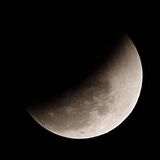
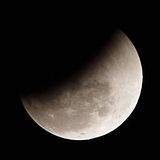
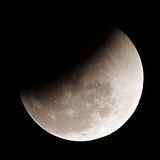
(Copyright, RiceHigh 2011. All Rights Reserved.)
This series of photos were taken by me in the late evening of December 10th at Hong Kong, for the Total Lunar Eclipse that took place for about 3 hours for the whole course. Full album here:-
http://smg.photobucket.com/albums/v313/RiceHigh/Gallery/Total_Lunar_Eclipse_2011-12-10/
(Or to view the Slideshow Here)
EXIF data are preserved. If you're interested in the shooting settings and other details, just have a look at them and go figure it out for yourself. :-) Live View and MF Assist were used for most of the shots.
Below was the gear I used, i.e., my Pentax K-r with a F*300/4.5 with or without a Kenko TelePlus Pro 300 (KAF2) 3X convertor:-
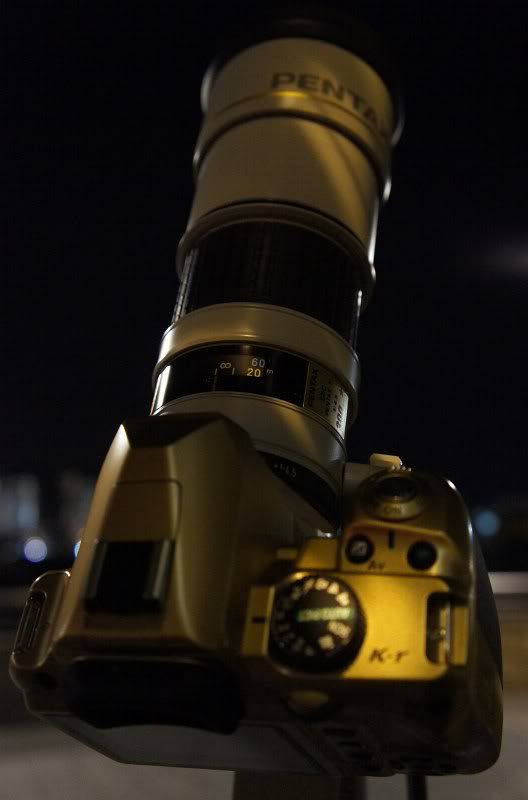
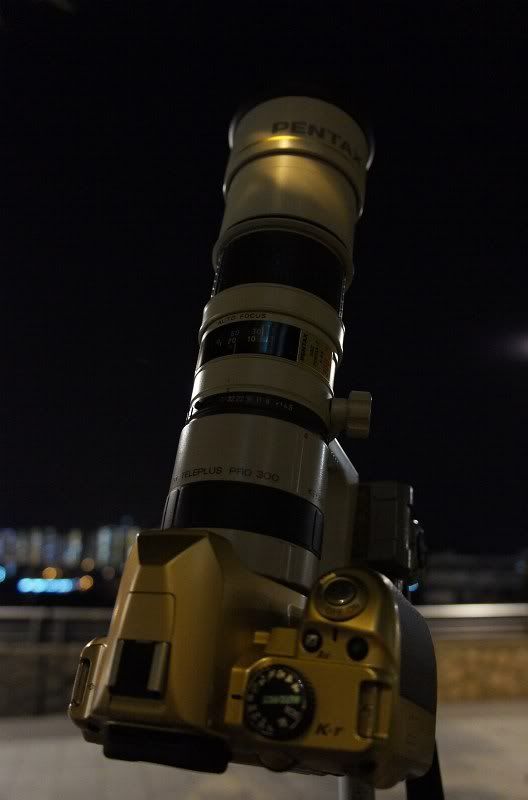
Friday, December 09, 2011
K-r Mirror Jumping / Disorder
Winter has once come and my K-x yet once again shows its double shutter actuation symptom in *singe*-frame advance mode at outdoor under a bit colder temperature (10+ deg. C)! :-(( In summer, that thing has never happened before!
So, I tried to do some web search to see if there is any solution but of course, my effort has been in vain! But during the course, I discovered this old video, about the K-r:-
(URL: http://www.youtube.com/watch?v=zmp9vkVahjg)
Too bad and terrible! The video speaks itself, I really have no more to say! >:-(
Related:-
K-r Mirror Jumping with Manual Lenses?
Search "K-5 Mirror Jumping" at This Blog
K-5 Has Got a Cold! :-o
My K-r Burnt my Sandisk and Went Nuts! :-(
So, I tried to do some web search to see if there is any solution but of course, my effort has been in vain! But during the course, I discovered this old video, about the K-r:-
(URL: http://www.youtube.com/watch?v=zmp9vkVahjg)
Too bad and terrible! The video speaks itself, I really have no more to say! >:-(
Related:-
K-r Mirror Jumping with Manual Lenses?
Search "K-5 Mirror Jumping" at This Blog
K-5 Has Got a Cold! :-o
My K-r Burnt my Sandisk and Went Nuts! :-(
Thursday, December 08, 2011
Pentax Q Korejanai-Robo
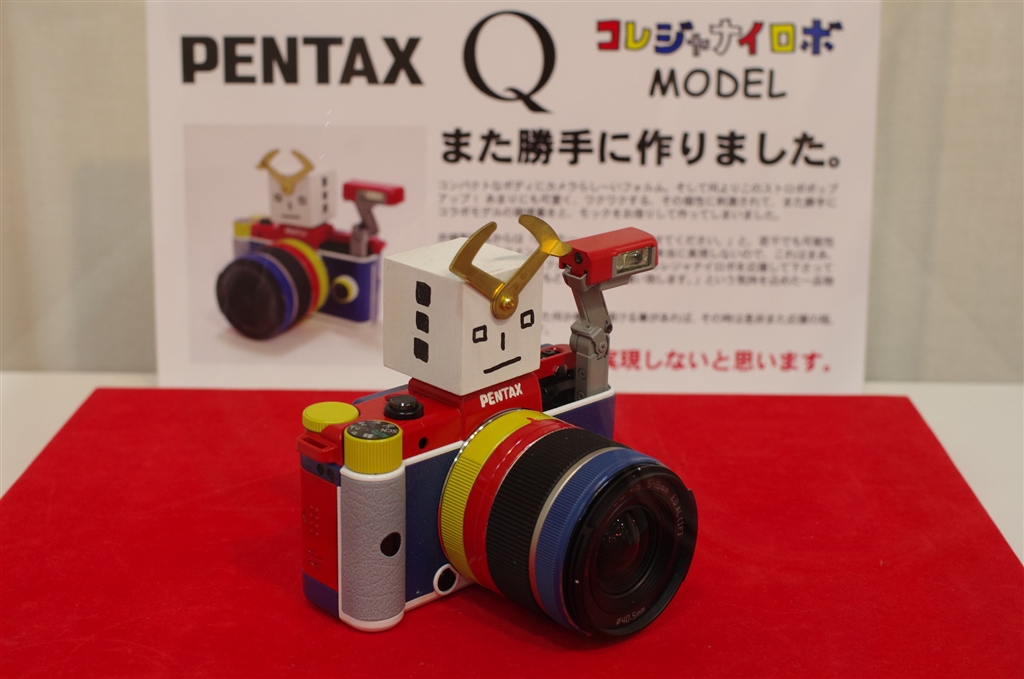
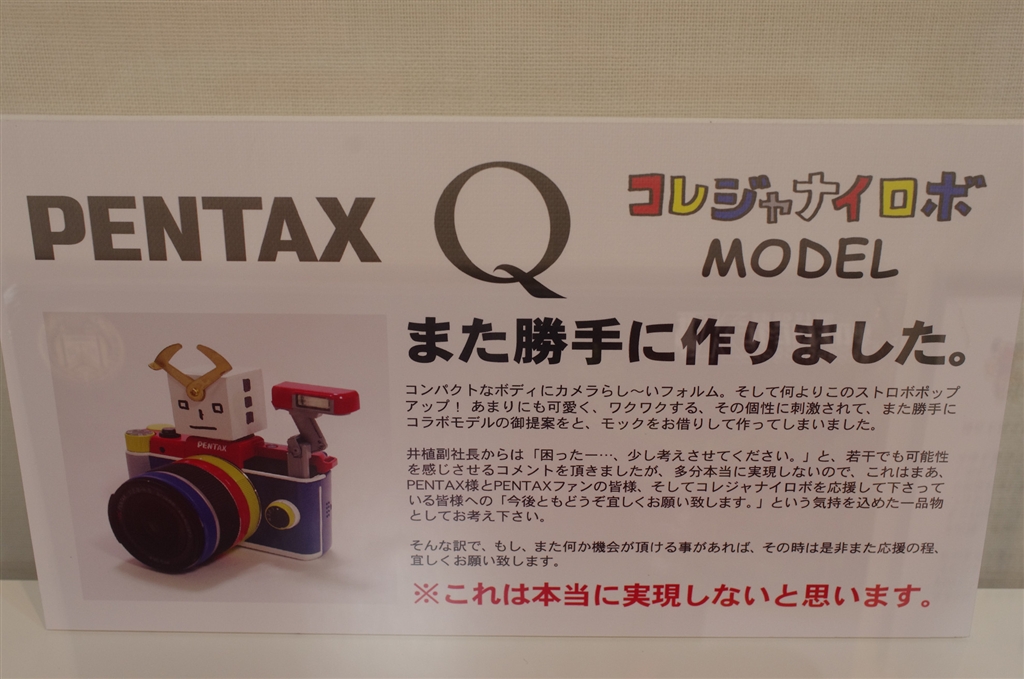
(Source: Japanese Kakaku Forum)
Oh, well.. What a TOY! :-o
Related:-
DSLRs that Can be Sold at the Toy "R" Us
Yet Another New Special Edition K-r
Pentax K-r Rilakkuma Limited Edition
The World's Ugliest Camera!
K-x Rainbow (Limited Edition)
Practical Solution to the Issue of Few Colour Options of the K-x outside Japan
Star Wars Stormtrooper K2000W LE ?
Tuesday, December 06, 2011
K-5 Lens Release Button Comes Off
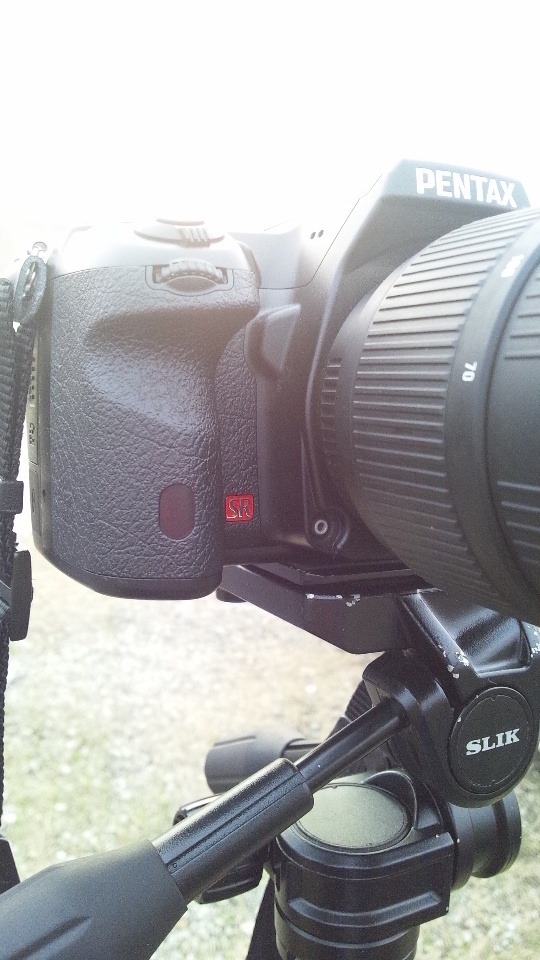
http://bbs.kakaku.com/bbs/K0000152653/SortID=13802697/
(in Japanese, Google English Translation Here)
Seems not an isolated case for what are reported for the same by different users in the same thread. Btw, at the end of the day, I just wonder, why Pentax DSLR flagships should have particular different weak points to break more easily from model to model?! :-o
Read Also:-
Dust Accumulates Inside the LCD of K-5
Vulnerability of the DAL Plastic Mount
Fragile K10D SR Switch Levers
K10D Dust Proof?
45 Most Powerful Photos of 2011






http://www.buzzfeed.com/mjs538/the-most-powerful-photos-of-2011
Touching and impressive photos, which record some special happenings of 2011 and the history of mankind. Yes, that's the power of photos, and true photos (not samples).
FA77 Limited Lens with Serial Number of 77
(Source Page: http://www.ebay.com/itm/260903810268?ssPageName=STRK:MEWAX:IT&_trksid=p3984.m1423.l2649)
Normally I just won't help other to promote anything here but with that marvel, I just can't help myself and I have no more to say! (The pictures speak themselves!) :-D
Monday, December 05, 2011
Sigma Starts to Drop In-Lens OS Support for Pentax

http://www.dpreview.com/news/2011/12/02/sigmanonOS1750F2p8
Well, maybe because the in-body SR of Pentax is so good! So why OS lenses? ;->
Related:-
When OIS Lenses are Put onto Sensor-shift IS Bodies..
In-Body Anti-Shake Patents Fully Dissected
Sensor-Shifted IS Heats Up the Sensor Much More Than the Video Mode Itself! :-o
When Our Video DSLRs Have High Fever.. :-o ;->
Saturday, December 03, 2011
Pentax UK and Pentax Germany Admitted K-r Tungsten Front Focusing Issue (But there is No Solution, as Both Clearly Told)
See these two reports and threads. They are 100% self-explanatory, with direct quotes from those Pentax officials:-
http://forums.dpreview.com/forums/readflat.asp?forum=1036&thread=39947770
http://forums.dpreview.com/forums/readflat.asp?forum=1036&thread=39975810
Btw, for what I have tested scientifically, that "specific spectrum of light" is called Infra Red. Red light does NOT cause any FF problem to the AF of the K-r, neither does the Green light, which *implies* Yellow light should NOT cause any problem neither! But since tungsten light sources do come with also strong IR spectra. So, it should be the real cause. I have also checked that adding a stronger Skylight 1B filter, which moderately suppresses both Green and Blue lights as well as IR, could lessen the FF very slightly. Thus, the dominant IR in environment should be the root cause to the problem as it is verified and re-confirmed.
After all, it seems that the AF sensors of the K-r are just too sensitive to IR but yet the IR cutting filter used in the AF module is either non-existent or is not strong enough and thus causing this problem - which could never be cured via firmware as it is a *hardware* issue, as I predicted on day one! (but then fanboys rebutted with NO ground and jumped on me, as usual!)
In fact, I confirmed this tungsten AF FF issue at the beginning of this year shortly after I purchased my K-r. I, as many other K-r users who have been suffering from the problem, of course was/were much disappointed for this step back of the SAFOX IX, especially for those who "upgraded" from a previous Pentax DSLR like the K-x and K-7, which do not have this severe issue.
Frankly, Pentax should have created a SAFOX IX-(minus) system instead of what is called the SAFOX+, adding what so-called an additional yellow-light detector won't help them and we end-users, BUT SIMPLY adding an IR cutting filter would! >:-(
Last but not least and still, here is my (repeated) advice for an interim measure to the problem: 1. Turn off the "AF Assist" light in the custom function and then 2. Set "AF Fine Adjust" to -10 (maximum value, my K-r usually focuses somehow acceptably at 0 under daylight for most of my Pentax lenses) and DO *remember* 3. Disable "AF Fine Adjust" after you return to non-tungsten environment and BEFORE you shoot! Easy Enough? :-o
Last Related:-
Still Annoying K-5 and K-r Old Issues, Users are Pissed Off!
http://forums.dpreview.com/forums/readflat.asp?forum=1036&thread=39947770
http://forums.dpreview.com/forums/readflat.asp?forum=1036&thread=39975810
Btw, for what I have tested scientifically, that "specific spectrum of light" is called Infra Red. Red light does NOT cause any FF problem to the AF of the K-r, neither does the Green light, which *implies* Yellow light should NOT cause any problem neither! But since tungsten light sources do come with also strong IR spectra. So, it should be the real cause. I have also checked that adding a stronger Skylight 1B filter, which moderately suppresses both Green and Blue lights as well as IR, could lessen the FF very slightly. Thus, the dominant IR in environment should be the root cause to the problem as it is verified and re-confirmed.
After all, it seems that the AF sensors of the K-r are just too sensitive to IR but yet the IR cutting filter used in the AF module is either non-existent or is not strong enough and thus causing this problem - which could never be cured via firmware as it is a *hardware* issue, as I predicted on day one! (but then fanboys rebutted with NO ground and jumped on me, as usual!)
In fact, I confirmed this tungsten AF FF issue at the beginning of this year shortly after I purchased my K-r. I, as many other K-r users who have been suffering from the problem, of course was/were much disappointed for this step back of the SAFOX IX, especially for those who "upgraded" from a previous Pentax DSLR like the K-x and K-7, which do not have this severe issue.
Frankly, Pentax should have created a SAFOX IX-(minus) system instead of what is called the SAFOX+, adding what so-called an additional yellow-light detector won't help them and we end-users, BUT SIMPLY adding an IR cutting filter would! >:-(
Last but not least and still, here is my (repeated) advice for an interim measure to the problem: 1. Turn off the "AF Assist" light in the custom function and then 2. Set "AF Fine Adjust" to -10 (maximum value, my K-r usually focuses somehow acceptably at 0 under daylight for most of my Pentax lenses) and DO *remember* 3. Disable "AF Fine Adjust" after you return to non-tungsten environment and BEFORE you shoot! Easy Enough? :-o
Last Related:-
Still Annoying K-5 and K-r Old Issues, Users are Pissed Off!
Friday, December 02, 2011
Calibrating (Colour Correcting) Your Monitor Using This Blog Page
About three years ago, I updated the colour scheme of my Blog. The look of the "new" colour scheme is not only about aesthetics, but there is a little secret that I have not told before.
That is, my Blog page could be used as a simple quick test target for colour calibration of your monitor! :-D
Now just note that the main text background of my Blog is in pure yellow in lighter/brighter tone. As such, it represents specific highlight colour accuracy in that colour. Pure yellow colour contains only Red and Green. So, you shouldn't see any colour cast except yellow if your monitor is colour corrected and the yellow should look as pure as possible.
Next, the Blog heading/title bar/area in in deep grey and the above principle also holds. Deep grey is one of the shallow representations. It should display equal Red, Green and Blue if the display device is colour corrected. If you have seen any colour cast in the title page, it simply means that there is colour errors with shallows of your display device!
As for the other minority colours of my Blog page in smaller areas, the remaining are light grey and white. Again, they should contain "no" colour~
Nowadays, most people use LCD monitors. And for most LCD monitors, there are settings for controlling the overall (backlight) brightness and the individual brightness (gain) of the R, G and B primitive colour channels. So, try to adjust all these four to get the best colours of my page, then you're almost close to a more colour-correct(ed) display for viewing images than what your monitor originally could do for you!
If your monitor also has the contrast (i.e., the back level) adjustment also, try to adjust the most suitable contrast and brightness first with a grey scale chart like that displayed in every DPR camera review. Then adjust the RGB gains and colours.
If you see that the (high)light colours of my Blog page contains more cast than the subject title area (for deeper tones/shadows) or vice versa, that means that the colour display errors of your monitor is not linear against the brightness (from dark/shallow to bright/highlight). So, you have to make the compromise and find the balance point. At the end of the day, there is not much to do unless you use an external hardware monitor colour calibration device to do the adjustment further.
After all the pure text talks above, let's look at the following screen capture of the "LUT" (stands for Look Up Table, download a LUT management utility here) colour correction curves of an eye-adjusted EIZO monitor of mine using my Blog page as target below:-
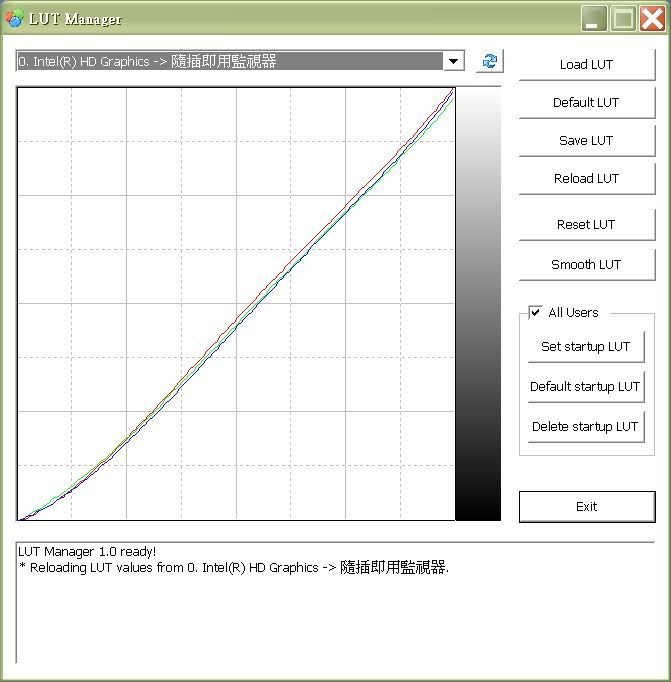
With the best factory colour profile without any "human" colour correction, the Spyder measured LUT table actually looks like this:-
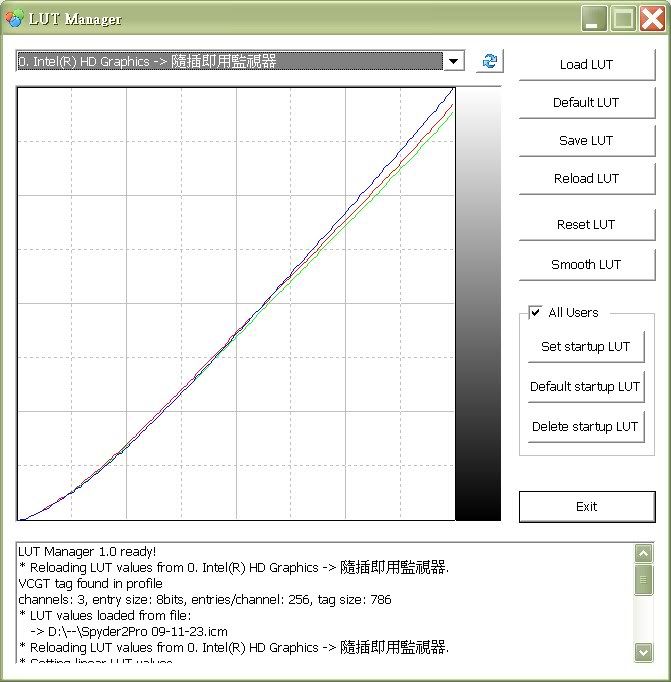
Note about Green and Red are suppressed so as to compensate for the yellow cast which is caused by the aging of my that monitor, which has been used for prolonged time of more than 3 thousand hours over years, particularly, the "white" fluorescent backlight source could become more yellowish.
So, it leads to an important tip for hardware calibrating monitors, i.e., one should *always* try to adjust the monitor to a better display status as far as possible by *own eyes* before hardware calibrating the display. The above example shows that the final display accuracy of the former hardware calibrated monitor is yet better than the latter. The difference is indeed quite obvious. It is because the lesser the original errors for correction, the better the final results will be - simple logic? :-)
Last but not least, you can see that the "better" RGB correction curves coincide with each others very well, that means that my eyes had actually been really accurate and the Spyder actually supports my judgement! ;-D However, do note that the gamma and contrast have still been adjusted and compensated by the Spyder somehow, as it can only be measured and corrected via the ICC/ICM profiles (i.e., the LUT table) by using the Spyder (or any other hardware monitor calibration device).
Read Also:-
My Spyder2(Pro) Retired..
Blueish "LED" Screens? (How To Make Them Colour "Correct"!)
Testing the Colour Accuracy of Your Display and Eyes!
That is, my Blog page could be used as a simple quick test target for colour calibration of your monitor! :-D
Now just note that the main text background of my Blog is in pure yellow in lighter/brighter tone. As such, it represents specific highlight colour accuracy in that colour. Pure yellow colour contains only Red and Green. So, you shouldn't see any colour cast except yellow if your monitor is colour corrected and the yellow should look as pure as possible.
Next, the Blog heading/title bar/area in in deep grey and the above principle also holds. Deep grey is one of the shallow representations. It should display equal Red, Green and Blue if the display device is colour corrected. If you have seen any colour cast in the title page, it simply means that there is colour errors with shallows of your display device!
As for the other minority colours of my Blog page in smaller areas, the remaining are light grey and white. Again, they should contain "no" colour~
Nowadays, most people use LCD monitors. And for most LCD monitors, there are settings for controlling the overall (backlight) brightness and the individual brightness (gain) of the R, G and B primitive colour channels. So, try to adjust all these four to get the best colours of my page, then you're almost close to a more colour-correct(ed) display for viewing images than what your monitor originally could do for you!
If your monitor also has the contrast (i.e., the back level) adjustment also, try to adjust the most suitable contrast and brightness first with a grey scale chart like that displayed in every DPR camera review. Then adjust the RGB gains and colours.
If you see that the (high)light colours of my Blog page contains more cast than the subject title area (for deeper tones/shadows) or vice versa, that means that the colour display errors of your monitor is not linear against the brightness (from dark/shallow to bright/highlight). So, you have to make the compromise and find the balance point. At the end of the day, there is not much to do unless you use an external hardware monitor colour calibration device to do the adjustment further.
After all the pure text talks above, let's look at the following screen capture of the "LUT" (stands for Look Up Table, download a LUT management utility here) colour correction curves of an eye-adjusted EIZO monitor of mine using my Blog page as target below:-

With the best factory colour profile without any "human" colour correction, the Spyder measured LUT table actually looks like this:-

Note about Green and Red are suppressed so as to compensate for the yellow cast which is caused by the aging of my that monitor, which has been used for prolonged time of more than 3 thousand hours over years, particularly, the "white" fluorescent backlight source could become more yellowish.
So, it leads to an important tip for hardware calibrating monitors, i.e., one should *always* try to adjust the monitor to a better display status as far as possible by *own eyes* before hardware calibrating the display. The above example shows that the final display accuracy of the former hardware calibrated monitor is yet better than the latter. The difference is indeed quite obvious. It is because the lesser the original errors for correction, the better the final results will be - simple logic? :-)
Last but not least, you can see that the "better" RGB correction curves coincide with each others very well, that means that my eyes had actually been really accurate and the Spyder actually supports my judgement! ;-D However, do note that the gamma and contrast have still been adjusted and compensated by the Spyder somehow, as it can only be measured and corrected via the ICC/ICM profiles (i.e., the LUT table) by using the Spyder (or any other hardware monitor calibration device).
Read Also:-
My Spyder2(Pro) Retired..
Blueish "LED" Screens? (How To Make Them Colour "Correct"!)
Testing the Colour Accuracy of Your Display and Eyes!